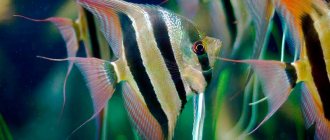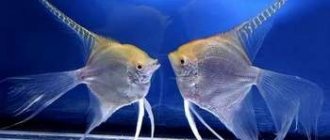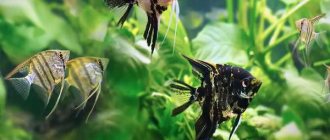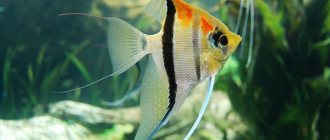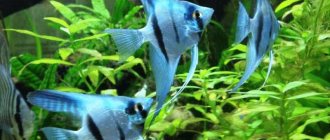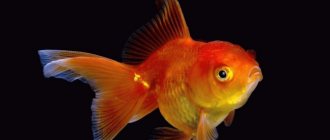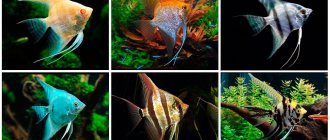Green angelfish compatibility
Green angelfish photo
By nature, angelfish are peaceful schooling fish, however, during the breeding season they become very aggressive. It easily gets along with peace-loving fish species: small tetras (neons, amanda tetras, etc.), they look good with swordtails. They go well with corydoras and small loricariid catfish.
Angelfish are incompatible with: guppies, goldfish. Although discus fish are also “relatives,” in our opinion, they are not the best neighbors for angelfish. Discus love warm water 30+, they are capricious, and grow into large fish. In general, we are in favor of keeping discus fish separately - in a species aquarium.
Breeding and propagation of angelfish Altum Orinoco
Angelfish Altum Orinoco - does not seem to be a morph
Males court females during the mating season. Both the male and the female guard the eggs, which are attached to the surface of aquatic vegetation in the area of the nest.
Sexual differences between male and female angelfish are weakly expressed. They can only be noticed when the fish reach sexual maturity at 9-12 months of age. Until this moment, when purchasing young specimens at a pet store, no one will tell you which one you are getting.
From fish breeding expert Vitaly Chernyavsky :
“1) Behavior is not a criterion. Quite often, 2 females without a male completely even (and in turns) imitate the sexual behavior of the male. Only, if you look closely, you can see that the “male” and the female will then switch places - and eggs (naturally unfertilized) will be laid by BOTH fish.
2) There are males without a forehead and females with a forehead.
3) The only clear criterion for sexual differences in adult fish is the line of the back and abdomen. In the male: the back line and dorsal fin form an ANGLE, and the abdomen and anal fin form an almost STRAIGHT line. But in the female it’s the other way around: the back line and dorsal fin are almost a STRAIGHT line, and the abdomen and anal fin are almost a right ANGLE.”
Taking into account the expert's opinion, we also add this drawing, which will help determine the sex of the Kalaria based on the angle of its fins.
!!!PLEASE ATTENTION!!!
The fact is that this drawing of an angelfish is distributed everywhere on the Internet with false information - the male and female are confused. This drawing is taken from Ilyin’s book “Aquarium Fish Farming”. So, there the fish were CONFUSED by the artist.
Well, on the Internet, those who make this drawing on their websites... do not themselves decide where the female is and where the male is, thereby misleading everyone. Everything is correct in this drawing!
With good and comfortable maintenance of the angelfish, spawning occurs directly in the general aquarium. The stimulus for spawning is replacing the aquarium water with fresh water and increasing the temperature by 2-4 degrees. The masonry substrate plays a very important role in this process. Angelfish often prefer to lay their eggs on a broad-leaved plant, but they may also like other places: a filter tube, glass, the wall of a grotto, etc.
The place chosen by the parents is carefully cleaned of all dirt, and then the spawning itself follows. At a time, a female can lay about 500 eggs, a large one and even more up to 1000.
The incubation period of the eggs is two days, during this period the parents vigorously fan the eggs with their fins and clean them of specks, and remove the whitened - dead eggs. After the larvae hatch from the eggs, the parents transfer them in their mouths to another leaf. This is done for greater cleanliness and to eliminate the possibility of catching an infection from the rotting shell of the caviar.
Over the next 7 days, the larvae, under the watchful supervision of their parents, hang on the leaf. When the larvae run out of nutrients from the yolk sac, they turn into fry. From this time they should start feeding.
Starter food for juvenile angelfish should be of high quality, live and well washed. I can recommend nauplii, nematodes. It is not advisable, but you can feed the fry with any ground dry food (this feeding will increase the number of dead fry). It is also recommended to clean the spawning aquarium from food debris and other dirt twice a day.
The above process is a reference example of angelfish reproduction.
Often, due to the proximity to other fish in a common aquarium, the parents experience a lot of stress, and the juveniles too. This, of course, does not lead to anything good. There have even been cases where parents, stressed by their neighbors, ate their offspring. In addition, due to the fact that in industrial breeding of angelfish, the method of spawning is used, it is now difficult to find a conscientious pair of parents who would be able to produce offspring on their own. This is considered a miracle.
With this in mind, usually immediately after spawning, the eggs with the leaf on which they are located are transplanted into another aquarium with a volume of 10-20 liters. In this case, all parental functions are transferred to your shoulders. To protect eggs from fungal diseases, methylene blue is added to the water, whitish dead eggs are regularly removed with a pipette, and a spray bottle with a very weak aerated flow of water is placed under the leaf.
Diseases of angelfish
Below are the most common symptoms of common angelfish diseases:
- rubs against various objects - invasion (fish semolina, oodium, etc.). It is treated with all drugs containing malachite green and formaldehyde: Tetra Contralk, Sera Kostapur, Antipar.
- produces rocking movements throughout the body, bloating, ruffling - inflammation of the gastrointestinal tract. If the stage is non-terminal, it is treated with metronidazole.
— The angelfish has a cloudy eye. As a rule, it occurs due to clashes. For mild injuries - iodinol. Moderate severity - Metrogyl is dripped directly onto the eye. Severe - serious septic tanks. In general, it goes away on its own within a couple of weeks (provided there are no further fights or stress).
- Moss, cotton wool fluff on the body - mushrooms. Any fungicidal agent. Regular methylene blue will help.
What to feed green angelfish?
The fish are omnivorous and absolutely unpretentious when it comes to food. Hamsters, both live and specialized food. As for branded foods, we recommend using time-tested Tetra foods. You can find out detailed information about them on the company’s official website - here .
Whatever your choice of food for aquarium fish, when purchasing, be sure to look at the expiration dates of the product, and do not buy food in bulk or in damaged packaging. Like any product, fish food deteriorates and if storage conditions are violated, pathogenic flora develops in it.
Breeding and propagation of green angelfish
Green angelfish photo
Males court females during the mating season. Both the male and the female guard the eggs, which are attached to the surface of aquatic vegetation in the area of the nest.
Sexual differences between male and female angelfish are weakly expressed. They can only be noticed when the fish reach sexual maturity at 9-12 months of age. Until this moment, when purchasing young specimens at a pet store, no one will tell you which one you are getting.
From fish breeding expert Vitaly Chernyavsky :
“1) Behavior is not a criterion. Quite often, 2 females without a male completely even (and in turns) imitate the sexual behavior of the male. Only, if you look closely, you can see that the “male” and the female will then switch places - and eggs (naturally unfertilized) will be laid by BOTH fish.
2) There are males without a forehead and females with a forehead.
3) The only clear criterion for sexual differences in adult fish is the line of the back and abdomen. In the male: the back line and dorsal fin form an ANGLE, and the abdomen and anal fin form an almost STRAIGHT line. But in the female it’s the other way around: the back line and dorsal fin are almost a STRAIGHT line, and the abdomen and anal fin are almost a right ANGLE.”
Taking into account the expert's opinion, we also add this drawing, which will help determine the sex of the Kalaria based on the angle of its fins.
!!!PLEASE ATTENTION!!!
The fact is that this drawing of an angelfish is distributed everywhere on the Internet with false information - the male and female are confused. This drawing is taken from Ilyin’s book “Aquarium Fish Farming”. So, there the fish were CONFUSED by the artist.
Well, on the Internet, those who make this drawing on their websites... do not themselves decide where the female is and where the male is, thereby misleading everyone. Everything is correct in this drawing!
With good and comfortable maintenance of the angelfish, spawning occurs directly in the general aquarium. The stimulus for spawning is replacing the aquarium water with fresh water and increasing the temperature by 2-4 degrees. The masonry substrate plays a very important role in this process. Angelfish often prefer to lay their eggs on a broad-leaved plant, but they may also like other places: a filter tube, glass, the wall of a grotto, etc.
The place chosen by the parents is carefully cleaned of all dirt, and then the spawning itself follows. At a time, a female can lay about 500 eggs, a large one and even more up to 1000.
The incubation period of the eggs is two days, during this period the parents vigorously fan the eggs with their fins and clean them of specks, and remove the whitened - dead eggs. After the larvae hatch from the eggs, the parents transfer them in their mouths to another leaf. This is done for greater cleanliness and to eliminate the possibility of catching an infection from the rotting shell of the caviar.
Over the next 7 days, the larvae, under the watchful supervision of their parents, hang on the leaf. When the larvae run out of nutrients from the yolk sac, they turn into fry. From this time they should start feeding.
Starter food for juvenile angelfish should be of high quality, live and well washed. I can recommend nauplii, nematodes. It is not advisable, but you can feed the fry with any ground dry food (this feeding will increase the number of dead fry). It is also recommended to clean the spawning aquarium from food debris and other dirt twice a day.
The above process is a reference example of angelfish reproduction.
Often, due to the proximity to other fish in a common aquarium, the parents experience a lot of stress, and the juveniles too. This, of course, does not lead to anything good. There have even been cases where parents, stressed by their neighbors, ate their offspring. In addition, due to the fact that in industrial breeding of angelfish, the method of spawning is used, it is now difficult to find a conscientious pair of parents who would be able to produce offspring on their own. This is considered a miracle.
With this in mind, usually immediately after spawning, the eggs with the leaf on which they are located are transplanted into another aquarium with a volume of 10-20 liters. In this case, all parental functions are transferred to your shoulders. To protect eggs from fungal diseases, methylene blue is added to the water, whitish dead eggs are regularly removed with a pipette, and a spray bottle with a very weak aerated flow of water is placed under the leaf.
Diseases of angelfish
Below are the most common symptoms of common angelfish diseases:
- rubs against various objects - invasion (fish semolina, oodium, etc.). It is treated with all drugs containing malachite green and formaldehyde: Tetra Contralk, Sera Kostapur, Antipar.
- produces rocking movements throughout the body, bloating, ruffling - inflammation of the gastrointestinal tract. If the stage is non-terminal, it is treated with metronidazole.
— The angelfish has a cloudy eye. As a rule, it occurs due to clashes. For mild injuries - iodinol. Moderate severity - Metrogyl is dripped directly onto the eye. Severe - serious septic tanks. In general, it goes away on its own within a couple of weeks (provided there are no further fights or stress).
- Moss, cotton wool fluff on the body - mushrooms. Any fungicidal agent. Regular methylene blue will help.
White angelfish 3-4 cm
READ AN ARTICLE ABOUT THESE AQUARIUM FISH ON OUR WEBSITE
Angelfish are traditionally considered by breeders to be one of the most popular aquarium fish.
In home and office aquariums you can find small flocks of these intelligent and beautiful creatures. Peaceful by nature, they will not offend other fish in the aquarium. For this quality they are highly valued by aquarists. At first, their calm, noble appearance may give the impression of an arrogant fish. But this is actually not the case: angelfish are very kind and cheerful creatures. Today it’s our turn to talk about white scalars - beautiful and unusual.
The white angelfish, of course, does not need additional advertising and description, because its body can be immediately noticed in the aquarium. You just need to distinguish between white angelfish and albino angelfish, whose eye iris is red.
Like other angelfish, white ones have a rounded body, flattened laterally, very long fins (on the back and anal), which are curved back and pointed. The body length of the fish is 10-15 cm, height - from twenty to twenty-five. The scales shimmer in the light with pearly tints.
An aquarist will not have any problems with keeping and breeding this variety of angelfish. It is quite unpretentious compared to other types of fish, despite its very noble, almost aristocratic appearance.
In an aquarium where white angelfish live, there is unlikely to be a fierce division of territories and a struggle for the best angle - these fish are very calm and peaceful. In a word, intellectuals.
The best part is that the fish gets along with many other species of aquatic life. When living together from a young age, she will not encroach on her little neighbors - guppies, neons, zebrafish, etc. The fish becomes irritable only during the period of mating activity and spawning.
White angelfish fish loves the dark color of loose soil, pleasant lighting, a relief bottom where it can hide, large amphibious plants and algae (it will need them during spawning - for spawning).
The water in the aquarium should be warm - from 24 to 27 degrees. The pH and hardness level should be 6-7. The water should be filtered constantly, replaced with fresh water - once a week for one quarter. Aeration is carried out twice a day - morning and evening, for twenty minutes.
The white angelfish is a very intelligent aquarium inhabitant that many breeders like. The pet looks impressive and behaves well
In the Exomenu online store you can buy white angelfish 3-4 cm at a bargain price. White angelfish 3-4 cm: customer reviews, characteristics, description, photographs, related products.
